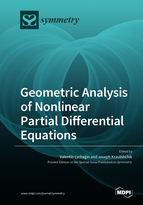Geometric Analysis of Nonlinear Partial Differential Equations
A special issue of Symmetry (ISSN 2073-8994). This special issue belongs to the section "Mathematics".
Deadline for manuscript submissions: closed (1 January 2021) | Viewed by 17108
Special Issue Editors
Interests: differential equations; symmetries; conservation laws; differential invariants; Integrability; singularities solutions; shock waves and phase transitions
Special Issues, Collections and Topics in MDPI journals
Interests: differential equations; nonlocal symmetries; conservation laws
Special Issues, Collections and Topics in MDPI journals
Special Issue Information
Dear Colleagues,
This Special Issue of Symmetry will be devoted to the observation of various geometrical structures associated with nonlinear partial differential equations as well as their symmetry and applications to integrability of the equations.
The main topics that we plan to discuss should be concentrated on different notions of symmetry and related to its invariants, conservation laws, and integrability. Its applications will also be of interest.
Prof. Dr. Lychagin Valentin
Dr. Joseph Krasilshchik
Guest Editors
Manuscript Submission Information
Manuscripts should be submitted online at www.mdpi.com by registering and logging in to this website. Once you are registered, click here to go to the submission form. Manuscripts can be submitted until the deadline. All submissions that pass pre-check are peer-reviewed. Accepted papers will be published continuously in the journal (as soon as accepted) and will be listed together on the special issue website. Research articles, review articles as well as short communications are invited. For planned papers, a title and short abstract (about 100 words) can be sent to the Editorial Office for announcement on this website.
Submitted manuscripts should not have been published previously, nor be under consideration for publication elsewhere (except conference proceedings papers). All manuscripts are thoroughly refereed through a single-blind peer-review process. A guide for authors and other relevant information for submission of manuscripts is available on the Instructions for Authors page. Symmetry is an international peer-reviewed open access monthly journal published by MDPI.
Please visit the Instructions for Authors page before submitting a manuscript. The Article Processing Charge (APC) for publication in this open access journal is 2400 CHF (Swiss Francs). Submitted papers should be well formatted and use good English. Authors may use MDPI's English editing service prior to publication or during author revisions.
Keywords
- differential equations
- symmetries
- conservation laws
- differential invariants
- integrability







